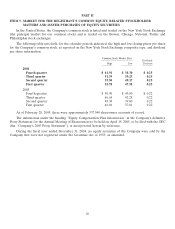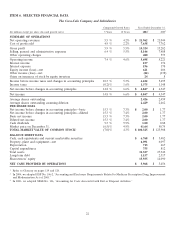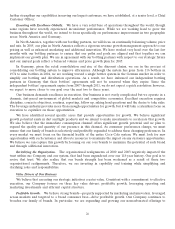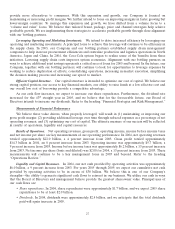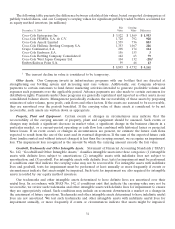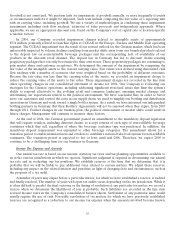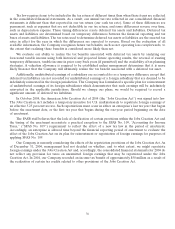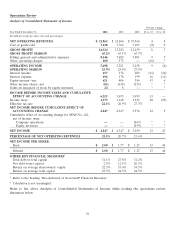Coca Cola 2004 Annual Report Download - page 32
Download and view the complete annual report
Please find page 32 of the 2004 Coca Cola annual report below. You can navigate through the pages in the report by either clicking on the pages listed below, or by using the keyword search tool below to find specific information within the annual report.
Share Repurchases
In October 1996, our Board of Directors authorized a plan (the ‘‘1996 Plan’’) to repurchase up to
206 million shares of our Company’s common stock through 2006. The table below presents shares repurchased
and average price per share under the 1996 Plan:
Year Ended December 31, 2004 2003 2002
Number of shares repurchased (in millions) 38 33 14
Average price per share $ 46.33 $ 44.33 $ 48.42
Since the inception of our initial share repurchase program in 1984 through our current program as of
December 31, 2004, we have purchased more than 1 billion shares of our Company’s common stock. This
represents 34.5 percent of the shares outstanding as of January 1, 1984 at an average price per share of $15.14.
We expect to repurchase at least $2 billion of the Company’s common stock in 2005. Because we expect our
operating cash flows to increase, we also expect to increase repurchases of the Company’s common stock in
subsequent years.
Dividends
At its February 2005 meeting, our Board of Directors again increased our quarterly dividend by 12 percent,
raising it to $0.28 per share, equivalent to a full-year dividend of $1.12 per share in 2005. This is our 43rd
consecutive annual increase. Our annual common stock dividend was $1.00 per share, $0.88 per share and $0.80
per share in 2004, 2003 and 2002, respectively. The 2004 dividend represented a 14 percent increase from 2003,
and the 2003 dividend represented a 10 percent increase from 2002.
Financial Risk Management
Our Company uses derivative financial instruments primarily to reduce our exposure to adverse fluctuations
in interest rates and foreign currency exchange rates and, to a lesser extent, adverse fluctuations in commodity
prices and other market risks. We do not enter into derivative financial instruments for trading purposes. As a
matter of policy, all our derivative positions are used to reduce risk by hedging an underlying economic
exposure. Because of the high correlation between the hedging instrument and the underlying exposure,
fluctuations in the value of the instruments are generally offset by reciprocal changes in the value of the
underlying exposure. Virtually all of our derivatives are straightforward, over-the-counter instruments with
liquid markets.
Foreign Currency. We manage most of our foreign currency exposures on a consolidated basis, which allows
us to net certain exposures and take advantage of any natural offsets. Approximately 78 percent of 2004
operating income was generated outside the United States; therefore, weakness in one particular currency is
often offset by strengths in others over time. We use derivative financial instruments to further reduce our net
exposure to currency fluctuations.
Our Company enters into forward exchange contracts and purchases currency options (principally euro and
Japanese yen) and collars to hedge certain portions of forecasted cash flows denominated in foreign currencies.
Additionally, we enter into forward exchange contracts to offset the earnings impact relating to exchange rate
fluctuations on certain monetary assets and liabilities. We also enter into forward exchange contracts as hedges
of net investments in international operations.
Interest Rates. We monitor our mix of fixed-rate and variable-rate debt, as well as our mix of term debt versus
nonterm debt. This monitoring includes a review of business and other financial risks as noted above. We also
enter into interest rate swap agreements to manage these risks.
Value at Risk. We monitor our exposure to financial market risks using several objective measurement
systems, including value-at-risk models. Our value-at-risk calculations use a historical simulation model to
30


